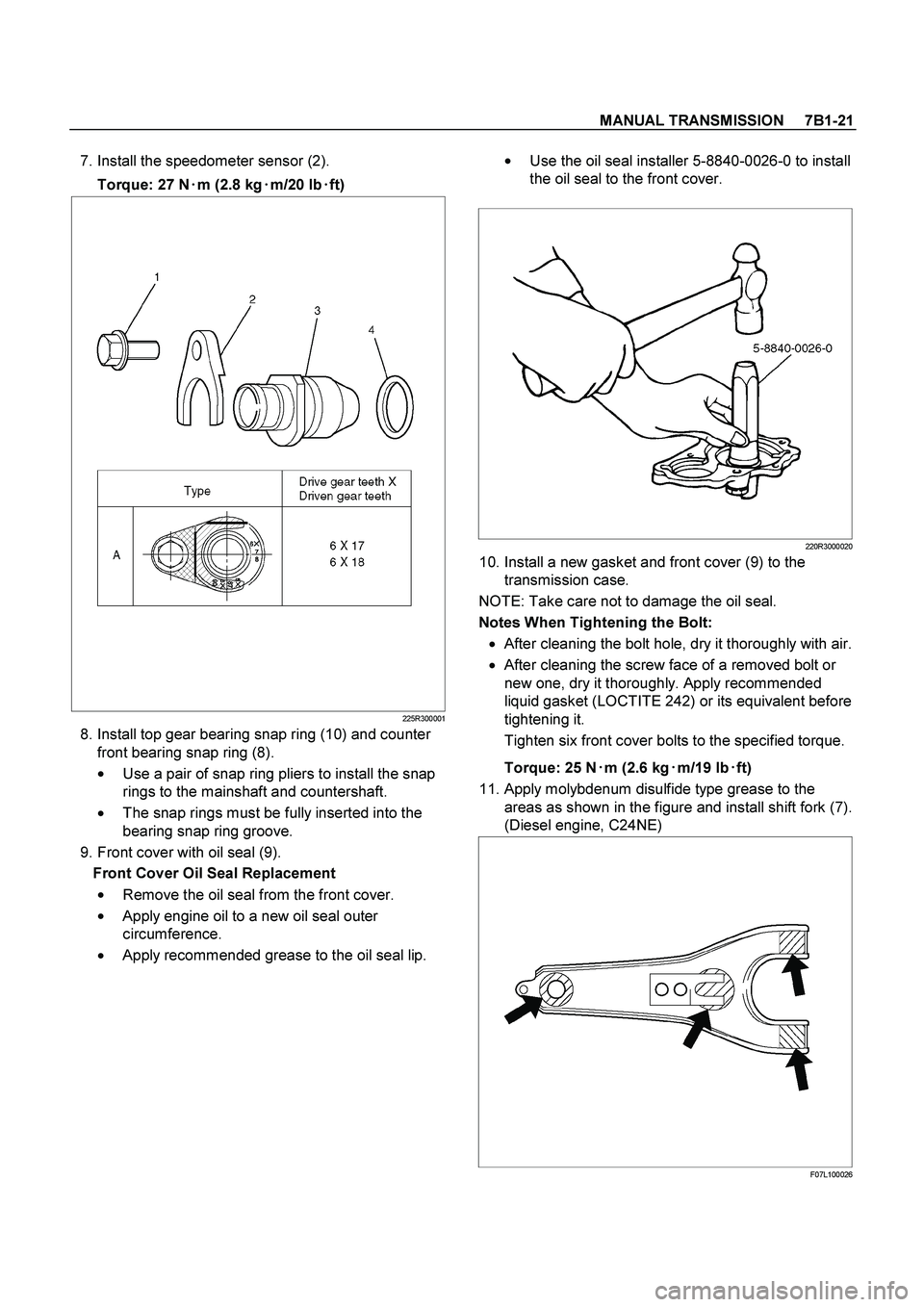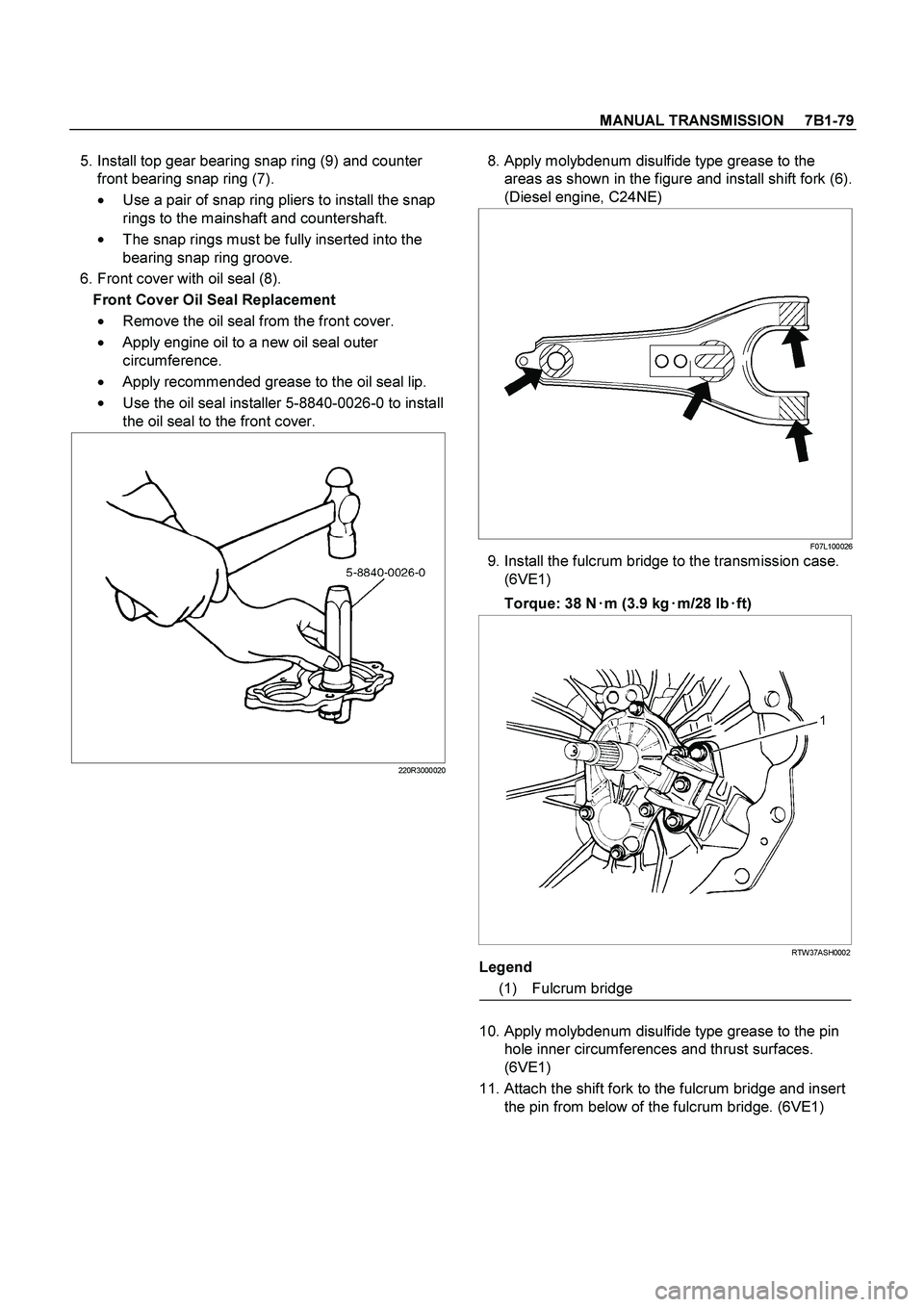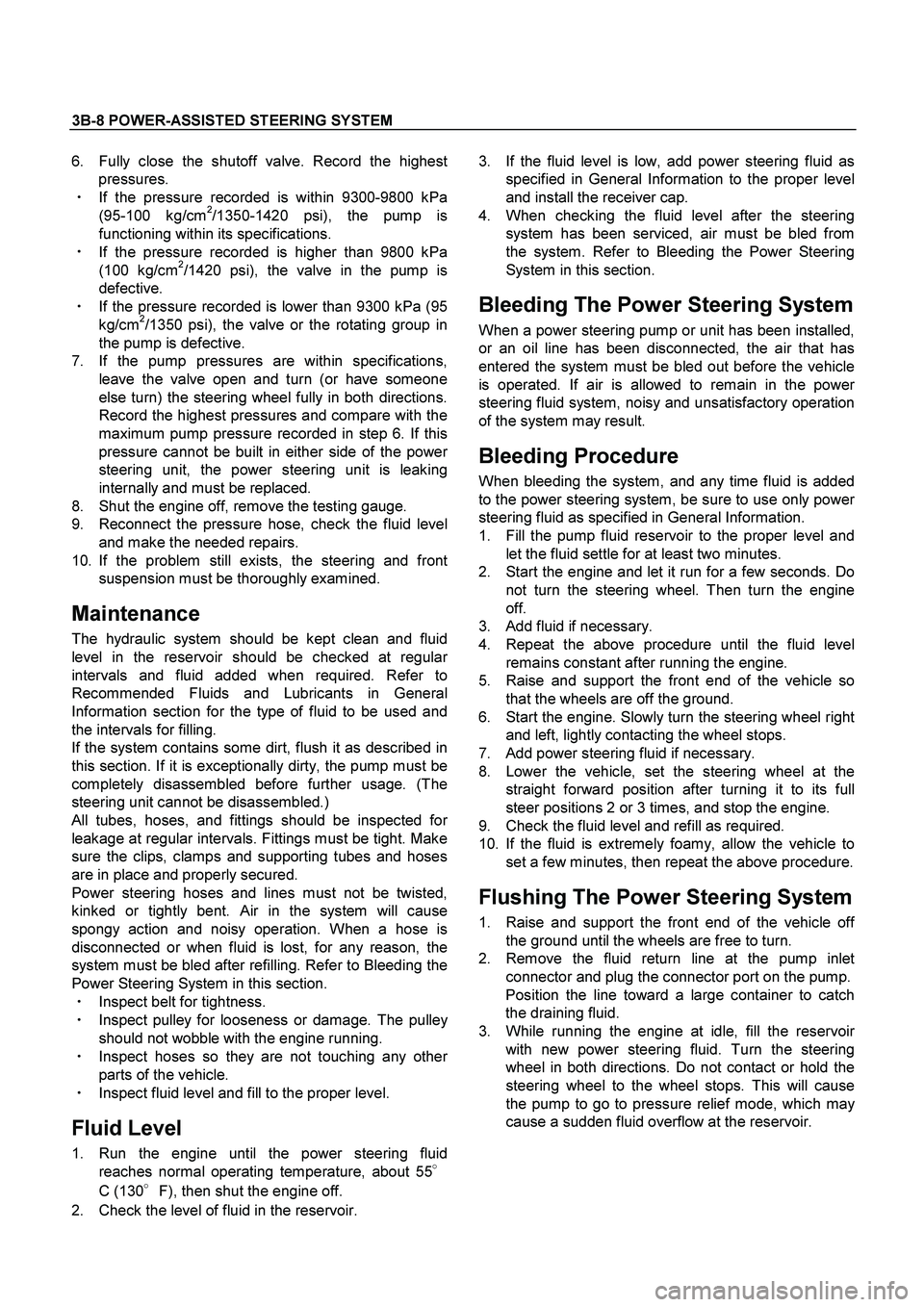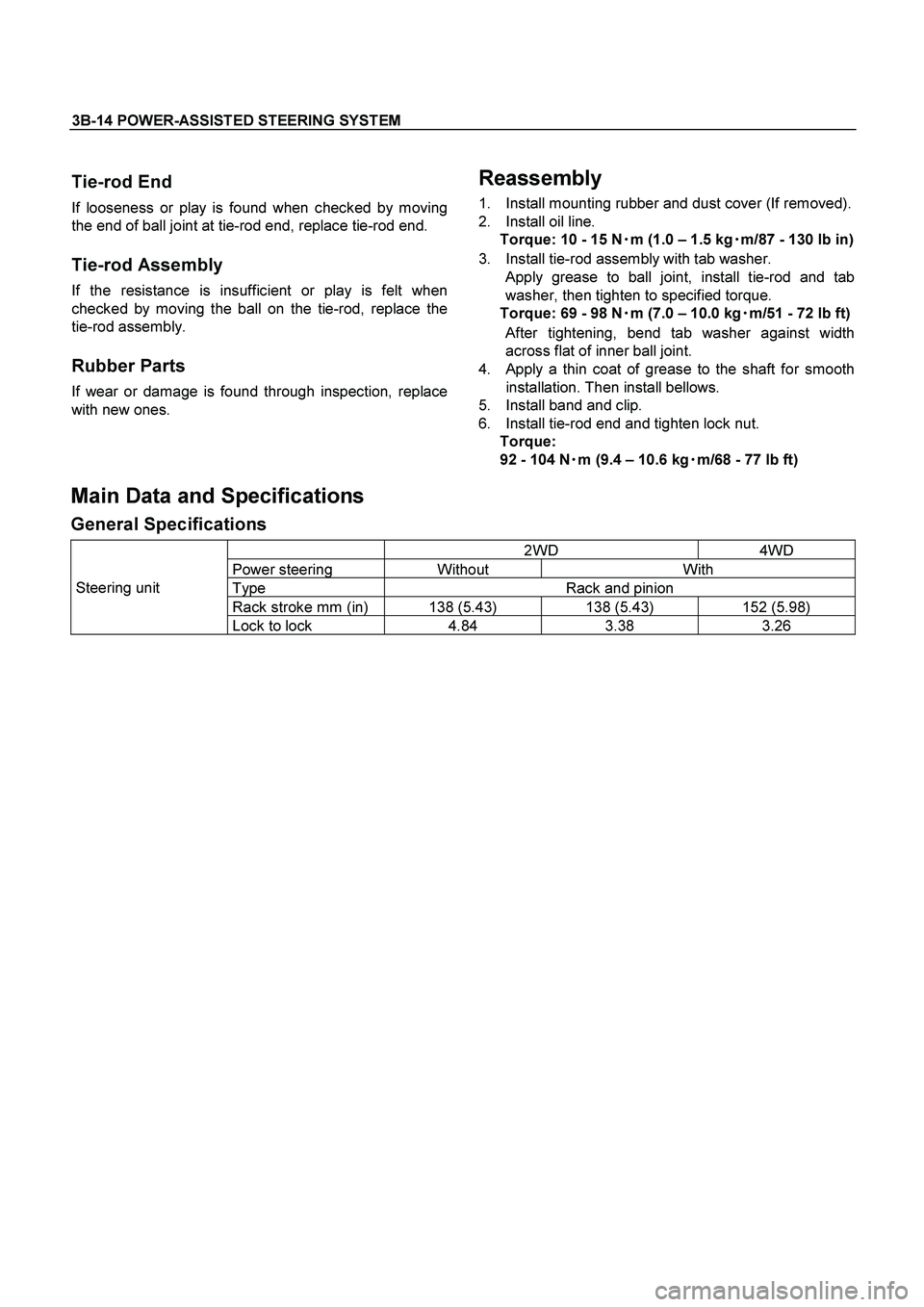Page 3185 of 4264

MANUAL TRANSMISSION 7B1-21
7. Install the speedometer sensor (2).
Torque: 27 N�
�� �m (2.8 kg�
�� �m/20 lb�
�� �ft)
225R300001
8. Install top gear bearing snap ring (10) and counter
front bearing snap ring (8).
�
Use a pair of snap ring pliers to install the snap
rings to the mainshaft and countershaft.
�
The snap rings must be fully inserted into the
bearing snap ring groove.
9. Front cover with oil seal (9).
Front Cover Oil Seal Replacement
�
Remove the oil seal from the front cover.
�
Apply engine oil to a new oil seal outer
circumference.
�
Apply recommended grease to the oil seal lip.
�
Use the oil seal installer 5-8840-0026-0 to install
the oil seal to the front cover.
220R3000020
10. Install a new gasket and front cover (9) to the
transmission case.
NOTE: Take care not to damage the oil seal.
Notes When Tightening the Bolt:
�
After cleaning the bolt hole, dry it thoroughly with air.
�
After cleaning the screw face of a removed bolt or
new one, dry it thoroughly. Apply recommended
liquid gasket (LOCTITE 242) or its equivalent before
tightening it.
Tighten six front cover bolts to the specified torque.
Torque: 25 N�
�� �
m (2.6 kg�
�� �
m/19 lb�
�� �
ft)
11. Apply molybdenum disulfide type grease to the
areas as shown in the figure and install shift fork (7).
(Diesel engine, C24NE)
F07L100026
Page 3214 of 4264
7B1-50 MANUAL TRANSMISSION
Main Data and Specifications
General Specifications
MUA 5G MUA 5S
Transmission type Fully synchronized forward and reverse gears
Control method Remote control with the gear shift lever on the floor.
Gear ratio: Transmission 1st 4.008 4.357
2nd 2.301 2.502
3rd 1.427 1.501
4th 1.000 1.000
5th 0.828 0.809
Rev. 3.651 3.970
Transmission oil capacity 2.95 lit. (3.12 US qt)
Type of lubricant Engine oil: Refer to the chart in "SECTION 0"
Page 3243 of 4264

MANUAL TRANSMISSION 7B1-79
5. Install top gear bearing snap ring (9) and counter
front bearing snap ring (7).
�
Use a pair of snap ring pliers to install the snap
rings to the mainshaft and countershaft.
�
The snap rings must be fully inserted into the
bearing snap ring groove.
6. Front cover with oil seal (8).
Front Cover Oil Seal Replacement
�
Remove the oil seal from the front cover.
�
Apply engine oil to a new oil seal outer
circumference.
� Apply recommended grease to the oil seal lip.
�
Use the oil seal installer 5-8840-0026-0 to install
the oil seal to the front cover.
220R3000020
8. Apply molybdenum disulfide type grease to the
areas as shown in the figure and install shift fork (6).
(Diesel engine, C24NE)
F07L100026
9. Install the fulcrum bridge to the transmission case.
(6VE1)
Torque: 38 N�
�� �m (3.9 kg�
�� �m/28 lb�
�� �ft)
RTW37ASH0002
Legend
(1) Fulcrum bridge
10. Apply molybdenum disulfide type grease to the pin
hole inner circumferences and thrust surfaces.
(6VE1)
11. Attach the shift fork to the fulcrum bridge and insert
the pin from below of the fulcrum bridge. (6VE1)
Page 3271 of 4264
MANUAL TRANSMISSION 7B1-107
Main Data and Specifications
General Specifications
MUA5G MUA5S
Transmission type Fully synchronized forward and reverse gears
Control method Remote control with the gear shift lever on the floor.
Gear ratio: Transmission 1st 4.008 4.357
2nd 2.301 2.502
3rd 1.427 1.501
4th 1.000 1.000
5th 0.828 0.809
Rev. 3.651 3.970
Transmission oil capacity 2.95 lit. (3.12 US qt)
Type of lubricant Engine oil: Refer to the chart in "SECTION 0"
Page 3434 of 4264
3B-4 POWER-ASSISTED STEERING SYSTEM
General Description
The hydraulic power steering system consists of a
pump, an oil reservoir, a steering unit, a pressure hose
and a return hose.
Power Steering Unit
This illustration is based on the RHD model. 440R300001
The power steering unit is rack and pinion type.
The toe-in angle can be adjusted by turning the rod on
each side.
The steering housing cannot be disassembled.
Page 3435 of 4264
POWER-ASSISTED STEERING SYSTEM 3B-5
Hydraulic Pump
442R300004
The hydraulic pump is vane-type design. The
submerged pump has housing and internal parts tha
t
are inside the reservoir and operate submerged in oil.
There are two bore openings at the rear of the pump
housing. The larger opening contains the cam ring,
pressure plate, thrust plate, rotor and vane assembly,
and end plate. The smaller opening contains the
pressure line union, flow control valve and spring.
The flow control orifice is part of the pressure line union.
The pressure relief valve inside the flow control valve
limits the pump pressure.
Page 3438 of 4264

3B-8 POWER-ASSISTED STEERING SYSTEM
6. Fully close the shutoff valve. Record the highest
pressures.
��
If the pressure recorded is within 9300-9800 kPa
(95-100 kg/cm
2/1350-1420 psi), the pump is
functioning within its specifications.
��
If the pressure recorded is higher than 9800 kPa
(100 kg/cm
2/1420 psi), the valve in the pump is
defective.
��
If the pressure recorded is lower than 9300 kPa (95
kg/cm
2/1350 psi), the valve or the rotating group in
the pump is defective.
7. If the pump pressures are within specifications,
leave the valve open and turn (or have someone
else turn) the steering wheel fully in both directions.
Record the highest pressures and compare with the
maximum pump pressure recorded in step 6. If this
pressure cannot be built in either side of the powe
r
steering unit, the power steering unit is leaking
internally and must be replaced.
8. Shut the engine off, remove the testing gauge.
9. Reconnect the pressure hose, check the fluid level
and make the needed repairs.
10. If the problem still exists, the steering and fron
t
suspension must be thoroughly examined.
Maintenance
The hydraulic system should be kept clean and fluid
level in the reservoir should be checked at regula
r
intervals and fluid added when required. Refer to
Recommended Fluids and Lubricants in General
Information section for the type of fluid to be used and
the intervals for filling.
If the system contains some dirt, flush it as described in
this section. If it is exceptionally dirty, the pump must be
completely disassembled before further usage. (The
steering unit cannot be disassembled.)
All tubes, hoses, and fittings should be inspected for
leakage at regular intervals. Fittings must be tight. Make
sure the clips, clamps and supporting tubes and hoses
are in place and properly secured.
Power steering hoses and lines must not be twisted,
kinked or tightly bent. Air in the system will cause
spongy action and noisy operation. When a hose is
disconnected or when fluid is lost, for any reason, the
system must be bled after refilling. Refer to Bleeding the
Power Steering System in this section.
��
Inspect belt for tightness.
��
Inspect pulley for looseness or damage. The pulle
y
should not wobble with the engine running.
��
Inspect hoses so they are not touching any othe
r
parts of the vehicle.
��
Inspect fluid level and fill to the proper level.
Fluid Level
1. Run the engine until the power steering fluid
reaches normal operating temperature, about 55�
C (130�
F), then shut the engine off.
2. Check the level of fluid in the reservoir.
3. If the fluid level is low, add power steering fluid as
specified in General Information to the proper level
and install the receiver cap.
4. When checking the fluid level after the steering
system has been serviced, air must be bled from
the system. Refer to Bleeding the Power Steering
System in this section.
Bleeding The Power Steering System
When a power steering pump or unit has been installed,
or an oil line has been disconnected, the air that has
entered the system must be bled out before the vehicle
is operated. If air is allowed to remain in the powe
r
steering fluid system, noisy and unsatisfactory operation
of the system may result.
Bleeding Procedure
When bleeding the system, and any time fluid is added
to the power steering system, be sure to use only powe
r
steering fluid as specified in General Information.
1. Fill the pump fluid reservoir to the proper level and
let the fluid settle for at least two minutes.
2. Start the engine and let it run for a few seconds. Do
not turn the steering wheel. Then turn the engine
off.
3. Add fluid if necessary.
4. Repeat the above procedure until the fluid level
remains constant after running the engine.
5. Raise and support the front end of the vehicle so
that the wheels are off the ground.
6. Start the engine. Slowly turn the steering wheel right
and left, lightly contacting the wheel stops.
7. Add power steering fluid if necessary.
8. Lower the vehicle, set the steering wheel at the
straight forward position after turning it to its full
steer positions 2 or 3 times, and stop the engine.
9. Check the fluid level and refill as required.
10. If the fluid is extremely foamy, allow the vehicle to
set a few minutes, then repeat the above procedure.
Flushing The Power Steering System
1. Raise and support the front end of the vehicle off
the ground until the wheels are free to turn.
2. Remove the fluid return line at the pump inlet
connector and plug the connector port on the pump.
Position the line toward a large container to catch
the draining fluid.
3. While running the engine at idle, fill the reservoi
r
with new power steering fluid. Turn the steering
wheel in both directions. Do not contact or hold the
steering wheel to the wheel stops. This will cause
the pump to go to pressure relief mode, which ma
y
cause a sudden fluid overflow at the reservoir.
Page 3444 of 4264

3B-14 POWER-ASSISTED STEERING SYSTEM
Tie-rod End
If looseness or play is found when checked by moving
the end of ball joint at tie-rod end, replace tie-rod end.
Tie-rod Assembly
If the resistance is insufficient or play is felt when
checked by moving the ball on the tie-rod, replace the
tie-rod assembly.
Rubber Parts
If wear or damage is found through inspection, replace
with new ones.
Reassembly
1. Install mounting rubber and dust cover (If removed).
2. Install oil line.
Torque: 10 - 15 N�
�� �m (1.0 – 1.5 kg�
�� �m/87 - 130 lb in)
3. Install tie-rod assembly with tab washer.
Apply grease to ball joint, install tie-rod and tab
washer, then tighten to specified torque.
Torque: 69 - 98 N�
�� �m (7.0 – 10.0 kg�
�� �m/51 - 72 lb ft)
After tightening, bend tab washer against width
across flat of inner ball joint.
4.
Apply a thin coat of grease to the shaft for smooth
installation. Then install bellows.
5. Install band and clip.
6. Install tie-rod end and tighten lock nut.
Torque:
92 - 104 N�
�� �m (9.4 – 10.6 kg�
�� �m/68 - 77 lb ft)
Main Data and Specifications
General Specifications
2WD 4WD
Power steering Without With
Type Rack and pinion
Rack stroke mm (in) 138 (5.43) 138 (5.43) 152 (5.98)
Steering unit
Lock to lock 4.84 3.38 3.26